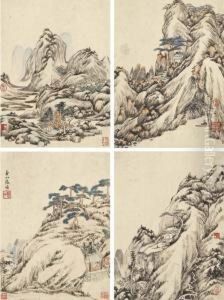Zhang Xun Paintings
Zhang Xun was a Chinese painter and calligrapher during the Ming Dynasty, whose life and career were emblematic of the scholarly pursuits and artistic achievements of his time. Born in 1416, Zhang Xun's contributions to Chinese art were reflective of the era's cultural renaissance, a period that saw significant developments in literature, philosophy, and the visual arts. His works are particularly noted for their integration of painting and calligraphy, a hallmark of Chinese scholarly art where the brush is used both for writing and painting, emphasizing the unity of literature and visual aesthetics.
Zhang Xun's artistic philosophy was deeply influenced by Confucian and Daoist thought, common among the literati of the Ming period. His paintings often featured landscapes, flowers, and birds, subjects that held deep symbolic meaning in Chinese culture and were regarded as meditative reflections on nature and the universe. These themes were not only popular among the literati class for their aesthetic appeal but also for their embodiment of moral virtues and philosophical ideals.
Throughout his career, Zhang Xun was known for his meticulous attention to detail and his mastery of brushwork. His style was both refined and expressive, capable of capturing the subtle nuances of the natural world as well as the inner emotions of the human spirit. His works were highly esteemed by his contemporaries and have continued to be revered in the centuries since his death in 1496.
Zhang Xun's legacy is preserved in various collections and museums, where his paintings and calligraphic works remain a testament to the artistic achievements of the Ming Dynasty. His influence extends beyond his own era, as he is celebrated for his contributions to the development of Chinese art, particularly in the realms of landscape and nature painting. Through his works, Zhang Xun has left an indelible mark on the history of Chinese art, embodying the intellectual and aesthetic ideals of his time.
